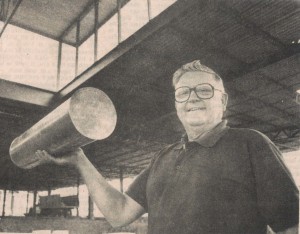Penn Central Mall: Vision and History Part 2

Pictured above is Richard “Sarge” Venter and the Penn Central Mall time capsule before it was sealed. The capsule contains many items including interviews with Oskaloosa school children predicting life in Oskaloosa in 2035. Venter was one of many who worked tirelessly to see the mall vision completed. The capsule will be opened on November 7, 2035. (photo courtesy of the Oskaloosa Herald)
This article is the second in a series of three about the Penn Central Mall development, people and future.
“The only constant is change (Isaac Asimov).” This well-known quote applies to just about everything – people, businesses and even communities.
Oskaloosa’s downtown began as a group of single-story wooden buildings and a few two and three-story brick buildings. Hitching posts served as parking stalls.
Over the next 120 years the Oskaloosa community grew and larger buildings developed in the central business district. In 1886, the courthouse was moved from its former location, northwest of the square, to its current location. Like the downtown, schools, churches, roads, parks housing and other parts of the community were built, renovated and reconstructed to allow for growth and change.
In 1984, one of the largest renewal projects in the community’s history occurred when a large, diverse team of residents came together to pursue redevelopment of the 16-block area in Oskaloosa’s downtown west side. Local banks, government officials, retailers, realtors, businesses, and citizen volunteers, teamed up to plan, design and build the mall.
“The project was something like an old-fashion barn raising to get the mall built. Everyone came together and took a specific role just like when barns were built 100 plus years ago.” said David Ahmad, Oskaloosa businessman and former co-owner of Alsop’s Department Store.
“Projects of certain magnitudes or size need more than one entity to move it forward, a single person can build a lean-to, but can’t build a barn. When railroads, telephones, electrical power came to Oskaloosa the same entities that put those projects together, put projects like the mall together. The type of project may change but the outcome is only possible with cooperation and shared vision,” he said.
“In order for a project like this to happen, people, groups, businesses, and organizations start apart and with differences. The project moves forward by first finding common connections. It is easier to move forward when the parties identify what they have in common, which is one reason that this project moved forward as fast as it did,” said Ahmad.
“The team didn’t look at this as change, but building for the future, while keeping some of the past that was viable,” said Ahmad. “This was evolution and progress for the heart of the community.”
All three local banks: Mahaska State Bank; Iowa Trust and Savings Bank; and Oskaloosa Home Loan stepped up with leadership and financial support, showing the importance of local banks and local ownership. In addition to helping the mall itself, they worked with relocating business owners to get financing approved quickly and to make the process easier. Their support contributed to the tone of long-term viability and relevance for Oskaloosa according to Ahmad.
The City Council, under the leadership and vision of Mayor Bob Lynn, held numerous meetings and took time to understand the project. The Council guided many of the decisions that were made. They took responsibility as applicant and administrator of the $3.4 million Urban Development Action Grant, and also assisted with the acquisition and relocation of businesses and people. The Chamber of Commerce’s support for the project made the Council’s job much easier.
Tenney Pickslay and Sandy McGregor were two key leaders in the retail community to lend their support to the mall project. Pickslay, of Alsop’s, was a respected business owner in the community. His early support for the project was important.
“On a side note, the lease at Alsop’s was running out about a year before the mall opened. The owners of the building lived out of town, but granted Alsop’s a one-year extension versus a 5 or 10-year lease which is standard,” said Ahmad. “The building owners looked at the mall as a benefit to both the square and the community.”
“The McGregor Furniture Store, managed by Sandy McGregor, had a successful business located in one of the few sound buildings in the redevelopment area,” said Ahmad. “They moved knowing that the mall would be good for the community and, in turn, their business. Sandy wanted to be part of the strong, long-term solution to keep the community vital,” he said.
Strong business leaders like Pickslay and McGregor, as well as others leading the way, helped build momentum among the business community to be supportive of the mall concept. “Ultimately, over 70% of the business community that would be impacted by the project was supportive,” said Ahmad. “They looked favorably at the project and what it would do for the long-term viability of Oskaloosa.”
Richard “Sarge” Venter’s role was project coordinator and he helped build connections with local people and was a troubleshooter throughout the project. “Sarge had a natural ability to find common ground with diverse groups,” said Joe Crookham, President of Musco and former mall board member. “Venter knew his skills would prove invaluable on a project of this magnitude to help resolve the little problems that popped up.”
Realtors were also important in keeping the project on schedule. Schedules were tight to find new properties for existing businesses and get them moved. Many of the area realtors were involved but none was more involved than John Garner. Sacrificing his own real estate business, John spent many hours on this project working with property and business owners to acquire the properties on behalf of the mall.
An important key to the community support the project enjoyed was the work of the consulting firm, Urban Programming Corporation from St. Louis. Their exhaustive study of existing and potential retail sales from Oskaloosa’s trade area documented the need for and potential impacts of the mall. Ultimately, the property tax revenue generated by the area grew from $70,000 in 1984 to over $400,000 today.
The Oskaloosa Development Foundation and other teams stepped up to raise money towards the $2 million goal to provide the local ownership that was an important part of this project. “Individuals who didn’t have financial resources to donate gave of their time and talent,” said Crookham.
David Ahmad remembers one such individual that believed in the project, “This guy with construction skills would show up everyday to help out on something. He spent many hours working on building the replica of the bandstand that once stood in the mall’s center court,” said Ahmad.
“It’s easy to recognize those whose names end up in the media,” he said, “but this was a community project that involved numerous leaders and individuals. It took a large portion of the community to understand and support the mall project. As communities change, the type of project they pursue may change, but the outcome is only possible with cooperation and shared vision”
Musco
Penn Central Mall















